
Introduction
Welcome to the May 2022 Apartment List National Rent Report. Rent growth is continuing to pick up steam again, after a brief winter cooldown, with our national index up by 0.9 percent over the course of April. So far this year, rents are growing more slowly than they did in 2021, but faster than the growth we observed in the years immediately preceding the pandemic. Year-over-year rent growth currently stands at a staggering 16.3 percent, but most of that growth took place last spring and summer. Over the first four months of 2022, rents have increased by a total of just 2.5 percent, though we’re only beginning to enter the busy season for the rental market, when the bulk of annual rent growth typically occurs.
On the supply side, our national vacancy index dipped slightly this month, the first time that vacancies have tightened since last August. Our vacancy index currently stands at 4.6 percent, up from a low of 3.8 percent last August, but still well below the pre-pandemic norm. Rents increased this month in 93 of the nation’s 100 largest cities, with Sun Belt markets in Florida and Arizona continuing to see some of the nation’s fastest growth.
Month-over-month rent growth picks back up with 0.9% increase; up 16.3% year-over-year
Our national rent index closed out 2021 with a 0.2 percent month-over-month decline, making December the only month last year in which rents fell. That price dip proved to be short lived, however, with rent growth returning to positive territory over the past four months. Our national rent index increased by 0.9 percent month-over-month in April. Rents grew nearly twice as fast at this time last year, with a 1.7 percent month-over-month increase in April 2021. In fact, this month’s increase looks more similar to the rates we observed in the years preceding the pandemic – from 2017 to 2019, month-over-month growth in April averaged 0.8 percent, just barely below this month’s 0.9 percent increase.
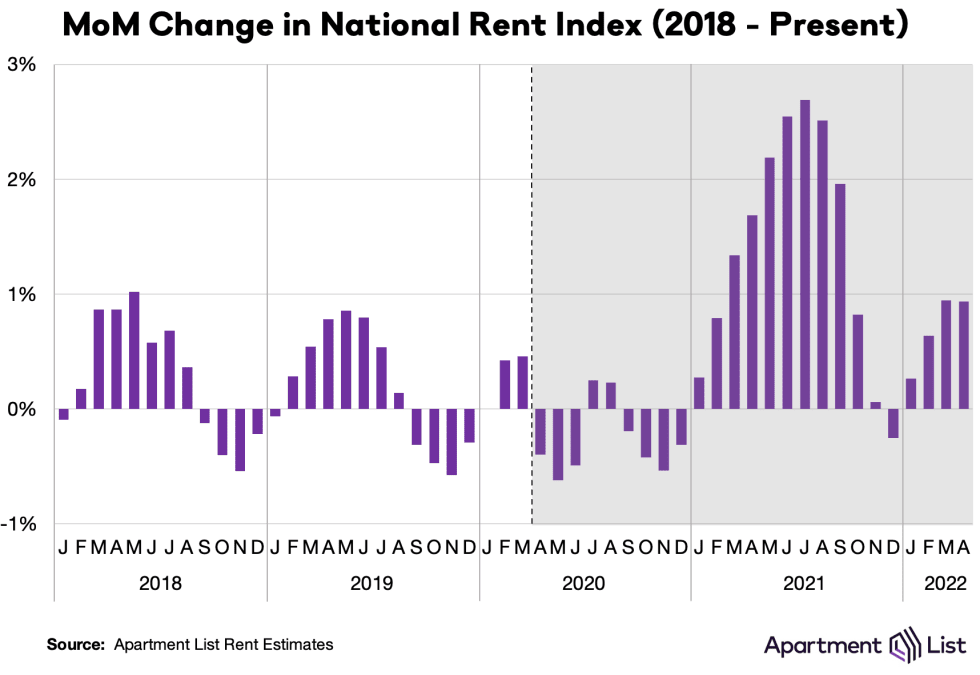
Growth has cooled down substantially from last summer’s peak, but the total increase in 2022 to-date is still pacing ahead of the pre-pandemic norm for this time of year. From January through April this year, rents nationally are up by a total of 2.5 percent, compared to 3.9 percent growth in the first four months of 2021. Over the same months of 2018 and 2019, rents grew by 1.9 percent and 1.6 percent, respectively.

Over the past 12 months as a whole, rent prices have spiked by an unprecedented 16.3 percent nationally. Rent growth over the past year has far outpaced that of any prior year in our estimates, which go back to 2017. For comparison, year-over-year rent growth in April averaged just 2.5 percent in 2018-2019. With the exception of last December, rents continued to trend upward through the winter slow season this year, and growth is now accelerating as we enter the Spring and Summer months, when rental activity is normally at its peak. Even if prices don’t rise as rapidly as they did in 2021, it’s likely that this year will continue to bring rent growth in excess of the pre-pandemic trend.
Vacancy remains low entering the rental busy season
As we’ve explored in detail, much of the 2021 rent boom was attributed to a tight market in which more households were competing for fewer vacant units. Our vacancy index spiked above 7 percent at the onset of the pandemic in 2020, as many Americans moved in with family or friends amid the uncertainty and economic disruption of the pandemic’s onset. After that, however, vacancies began a steady decline, eventually falling below 4 percent.
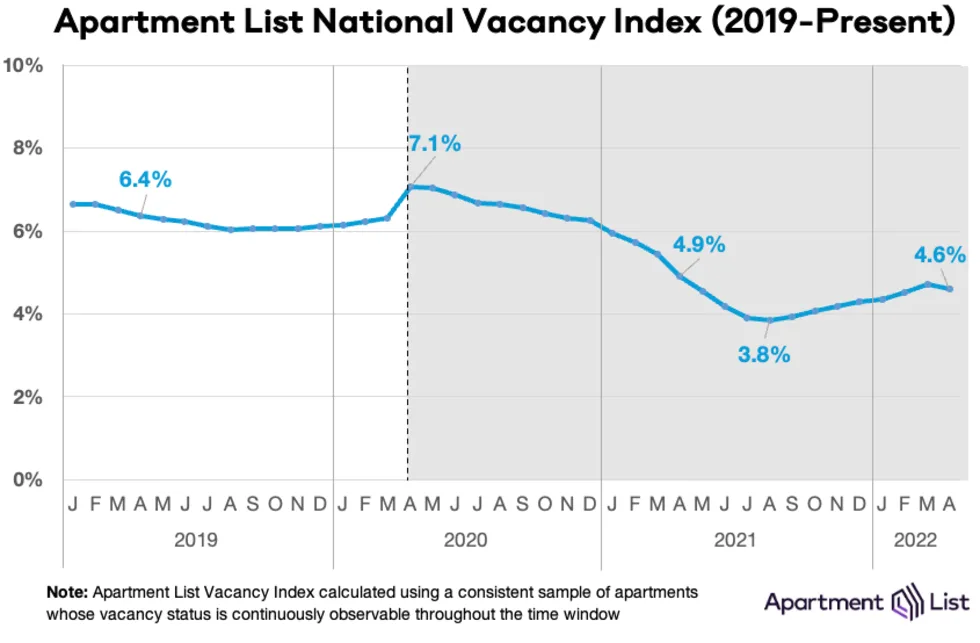
After bottoming out at 3.8 percent last August, our vacancy index slowly ticked back up for seven consecutive months, until dipping slightly this month. Our index fell from 4.7 percent in March to 4.6 percent in April. We should be hesitant to put too much stock into a single data point, but it’s possible that as we enter the traditional busy season for the rental market, the gradual easing of our vacancy index may begin to level off. The vacancy situation remains historically tight, and even if it were to continue gradually easing, it will likely be some time before we get back to the pre-pandemic norm.
Rents up month-over-month in 93 of 100 largest cities
If 2020 was characterized by price convergence (expensive cities getting cheaper and cheaper cities getting more expensive), 2021 was characterized by price inflation: cities large and small getting more expensive, rapidly. This can be seen in the chart below, which visualizes monthly rent changes in each of the nation’s 100 largest cities from January 2018 to present. The color in each cell represents the extent to which prices went up (red) or down (blue) in a given city in a given month. The band of dark red in 2021 depicts last year’s rent heatwave, which peaked in July and August 2021 when all 100 cities in this chart saw prices go up. Meanwhile, the rightmost columns show rent growth falling back to more reasonable levels in recent months. In December 2021, rents fell in 61 of the nation’s 100 largest cities, the only month last year in which more than half of these cities saw a decline. This month, however, rents were up in 93 of the nation’s 100 largest cities.

While rent growth has slowed nationally, not every city has followed the same trajectory. Most of the 100 cities in the chart above have seen at least one month of falling rents over the past six months, but in 25 of these cities – primarily scattered across the Sun Belt – prices have continued to trend consistently upward, even if the pace has slowed. At the other end of the spectrum, there are 22 cities where the median rent is currently lower than it was last October. Whereas 2021 saw rapid rent growth across the U.S., different parts of the country are now seeing prices trend in opposite directions.
Rents continuing to climb rapidly in FL and AZ metros
As mentioned above, major markets throughout the Sun Belt have experienced virtually-uninterrupted rent growth since the start of the pandemic. The following table shows rent growth for the ten metropolitan areas that have experienced the fastest rent growth over the past six months, over the past year, and since the pandemic started in March 2020:
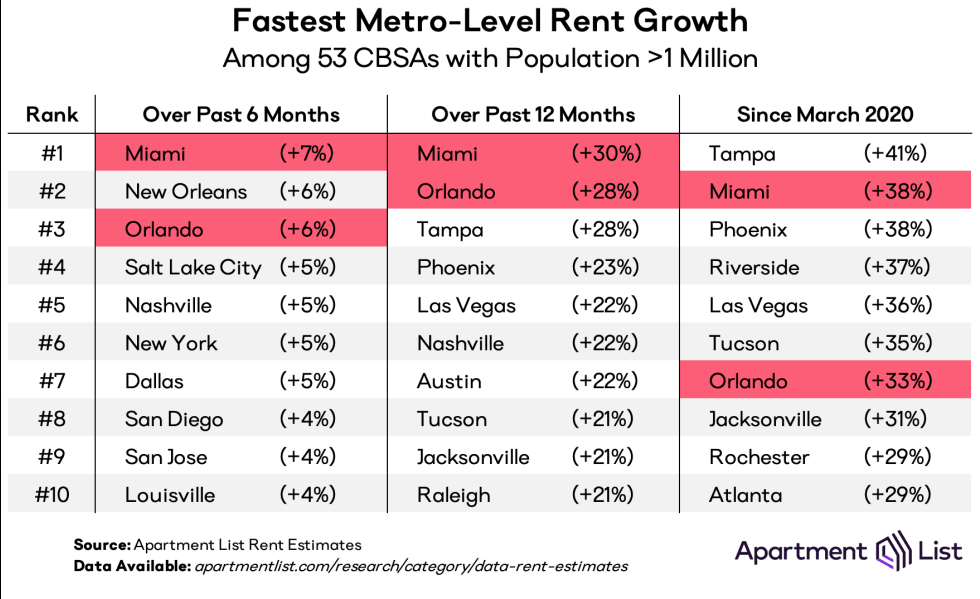
The Miami metro has seen the nation’s fastest growth over the past six months (+7 percent), nearly tripling the growth rate of our national index over that period. The Miami metro also ranks #1 for year-over-year rent growth, and #2 for growth since March 2020. Orlando is the only other metro to land in the top 10 across all three of these time horizons. The Tampa metro has had the fastest rent growth over the course of the pandemic as a whole, with a staggering 41 percent increase. However, growth in Tampa has cooled down in recent months, with a more modest 1.6 percent increase since last September, which is actually slower than the national average. Similarly, the Riverside, CA metro ranks #4 for growth since March 2020, but a relatively large share of that growth occurred in 2020, and Riverside has fallen out of the top ten over the past year. On the other hand, we’ve also seen some metros heating up in recent months which had not been among the hottest markets in the earlier phases of the pandemic – the New Orleans, Salt Lake City, Nashville, New York, Dallas, San Diego, San Jose, and Louisville metros each appear in the top ten in only the six-month column.
Only the San Francisco Bay Area still lags pre-pandemic rent levels (barely)
At the other end of the spectrum, a number of markets have seen much more modest rent growth since the start of the pandemic. These are generally a mix of pricey coastal metros, where rents fell sharply in 2020 followed by a rebound last year, and Rust Belt metros, where growth has consistently been sluggish compared to the national average. The table below is analogous to the one above, but shows the metros where rent growth has been slowest:
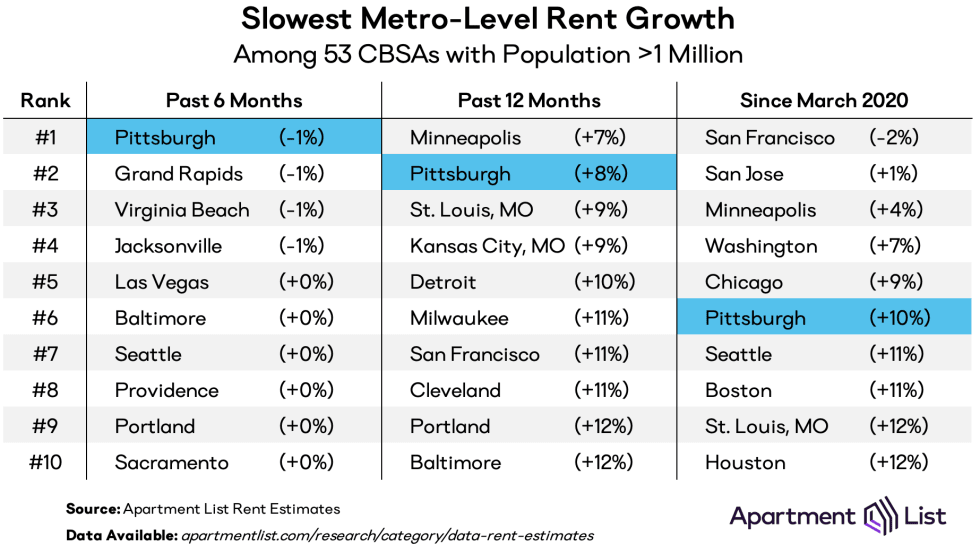
In the San Francisco metro, rents are still 2 percent lower than they were in March 2020, but this is the only metro where the median rent is still below pre-pandemic levels, and it will likely catch up within the next couple of months. The cities of Minneapolis, Washington, D.C., and Seattle are still slightly trailing pre-pandemic rents, but in these markets, the discounts do not extend metro-wide. The Pittsburgh metro is the only one which appears in all three columns. Minneapolis has seen the slowest rent growth over the past year, but its 7 percent increase would have been considered substantial in a typical pre-pandemic year. For comparison, over the course of 2019, just one large metro experienced rent growth above 7 percent.
Conclusion
After a brief seasonal reprieve, rents are back on the rise, with a 0.9 percent increase in April. Although rent growth has cooled from last summer’s peak, it continues to exceed pre-pandemic trends. While the apartment market has shown some signs of easing, our vacancy index dipped slightly to 4.6 percent this month, well below the 6 percent pre-pandemic norm. As we enter the spring and summer months, rental activity is likely to pick up, and rent growth is likely to accelerate. Despite a recent cool-down, many American renters are likely to remain burdened throughout 2022 by historically high housing costs.
For complete data, explore the interactive map below or head over to our rental data page, where you can download the most recent estimates for your city, as well as historic data going back to 2017. And as always, feel free to contact us with any questions!
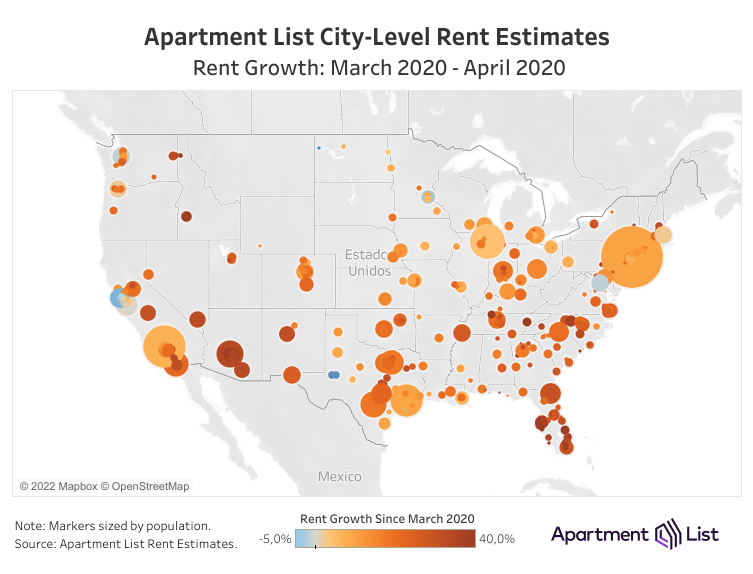
To learn more about the data behind this article and what Apartment List has to offer, visit https://www.apartmentlist.com/.







Sign up to receive our stories in your inbox.
Data is changing the speed of business. Investors, Corporations, and Governments are buying new, differentiated data to gain visibility make better decisions. Don't fall behind. Let us help.













Sign up to receive our stories in your inbox.
Data is changing the speed of business. Investors, Corporations, and Governments are buying new, differentiated data to gain visibility make better decisions. Don't fall behind. Let us help.





